Sanghyeon Lee
Strict Subgoal Execution: Reliable Long-Horizon Planning in Hierarchical Reinforcement Learning
Jun 26, 2025Abstract:Long-horizon goal-conditioned tasks pose fundamental challenges for reinforcement learning (RL), particularly when goals are distant and rewards are sparse. While hierarchical and graph-based methods offer partial solutions, they often suffer from subgoal infeasibility and inefficient planning. We introduce Strict Subgoal Execution (SSE), a graph-based hierarchical RL framework that enforces single-step subgoal reachability by structurally constraining high-level decision-making. To enhance exploration, SSE employs a decoupled exploration policy that systematically traverses underexplored regions of the goal space. Furthermore, a failure-aware path refinement, which refines graph-based planning by dynamically adjusting edge costs according to observed low-level success rates, thereby improving subgoal reliability. Experimental results across diverse long-horizon benchmarks demonstrate that SSE consistently outperforms existing goal-conditioned RL and hierarchical RL approaches in both efficiency and success rate.
PRISM: A Robust Framework for Skill-based Meta-Reinforcement Learning with Noisy Demonstrations
Feb 06, 2025



Abstract:Meta-reinforcement learning (Meta-RL) facilitates rapid adaptation to unseen tasks but faces challenges in long-horizon environments. Skill-based approaches tackle this by decomposing state-action sequences into reusable skills and employing hierarchical decision-making. However, these methods are highly susceptible to noisy offline demonstrations, resulting in unstable skill learning and degraded performance. To overcome this, we propose Prioritized Refinement for Skill-Based Meta-RL (PRISM), a robust framework that integrates exploration near noisy data to generate online trajectories and combines them with offline data. Through prioritization, PRISM extracts high-quality data to learn task-relevant skills effectively. By addressing the impact of noise, our method ensures stable skill learning and achieves superior performance in long-horizon tasks, even with noisy and sub-optimal data.
Enabling Region-Specific Control via Lassos in Point-Based Colorization
Dec 18, 2024



Abstract:Point-based interactive colorization techniques allow users to effortlessly colorize grayscale images using user-provided color hints. However, point-based methods often face challenges when different colors are given to semantically similar areas, leading to color intermingling and unsatisfactory results-an issue we refer to as color collapse. The fundamental cause of color collapse is the inadequacy of points for defining the boundaries for each color. To mitigate color collapse, we introduce a lasso tool that can control the scope of each color hint. Additionally, we design a framework that leverages the user-provided lassos to localize the attention masks. The experimental results show that using a single lasso is as effective as applying 4.18 individual color hints and can achieve the desired outcomes in 30% less time than using points alone.
Anomaly Detection for People with Visual Impairments Using an Egocentric 360-Degree Camera
Nov 17, 2024Abstract:Recent advancements in computer vision have led to a renewed interest in developing assistive technologies for individuals with visual impairments. Although extensive research has been conducted in the field of computer vision-based assistive technologies, most of the focus has been on understanding contexts in images, rather than addressing their physical safety and security concerns. To address this challenge, we propose the first step towards detecting anomalous situations for visually impaired people by observing their entire surroundings using an egocentric 360-degree camera. We first introduce a novel egocentric 360-degree video dataset called VIEW360 (Visually Impaired Equipped with Wearable 360-degree camera), which contains abnormal activities that visually impaired individuals may encounter, such as shoulder surfing and pickpocketing. Furthermore, we propose a new architecture called the FDPN (Frame and Direction Prediction Network), which facilitates frame-level prediction of abnormal events and identifying of their directions. Finally, we evaluate our approach on our VIEW360 dataset and the publicly available UCF-Crime and Shanghaitech datasets, demonstrating state-of-the-art performance.
Exclusively Penalized Q-learning for Offline Reinforcement Learning
May 23, 2024



Abstract:Constraint-based offline reinforcement learning (RL) involves policy constraints or imposing penalties on the value function to mitigate overestimation errors caused by distributional shift. This paper focuses on a limitation in existing offline RL methods with penalized value function, indicating the potential for underestimation bias due to unnecessary bias introduced in the value function. To address this concern, we propose Exclusively Penalized Q-learning (EPQ), which reduces estimation bias in the value function by selectively penalizing states that are prone to inducing estimation errors. Numerical results show that our method significantly reduces underestimation bias and improves performance in various offline control tasks compared to other offline RL methods
iColoriT: Towards Propagating Local Hint to the Right Region in Interactive Colorization by Leveraging Vision Transformer
Jul 15, 2022
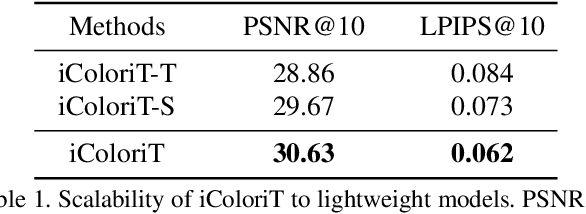


Abstract:Point-interactive image colorization aims to colorize grayscale images when a user provides the colors for specific locations. It is essential for point-interactive colorization methods to appropriately propagate user-provided colors (i.e., user hints) in the entire image to obtain a reasonably colorized image with minimal user effort. However, existing approaches often produce partially colorized results due to the inefficient design of stacking convolutional layers to propagate hints to distant relevant regions. To address this problem, we present iColoriT, a novel point-interactive colorization Vision Transformer capable of propagating user hints to relevant regions, leveraging the global receptive field of Transformers. The self-attention mechanism of Transformers enables iColoriT to selectively colorize relevant regions with only a few local hints. Our approach colorizes images in real-time by utilizing pixel shuffling, an efficient upsampling technique that replaces the decoder architecture. Also, in order to mitigate the artifacts caused by pixel shuffling with large upsampling ratios, we present the local stabilizing layer. Extensive quantitative and qualitative results demonstrate that our approach highly outperforms existing methods for point-interactive colorization, producing accurately colorized images with a user's minimal effort.
Deep Edge-Aware Interactive Colorization against Color-Bleeding Effects
Jul 04, 2021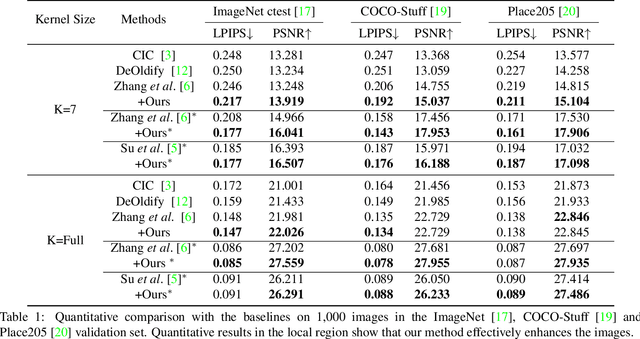
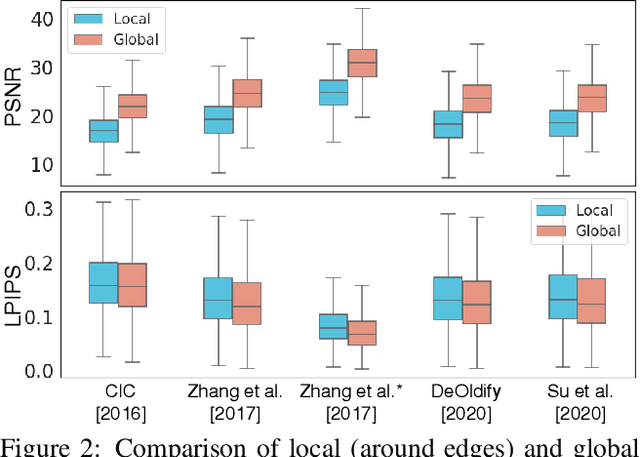
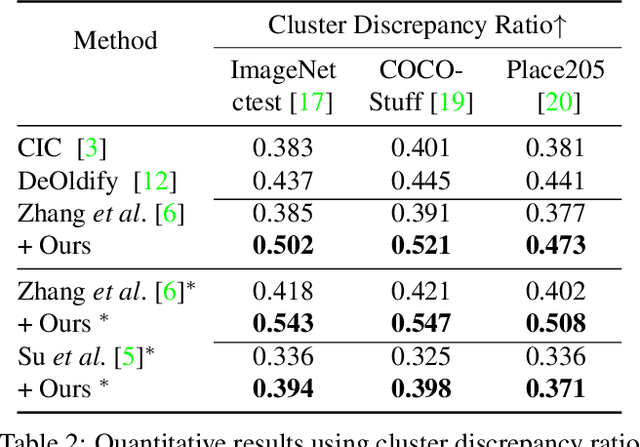
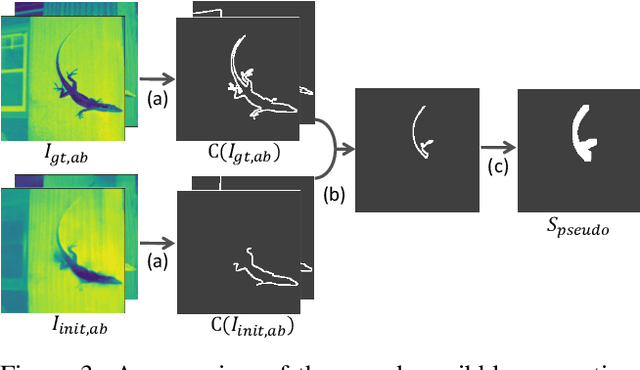
Abstract:Deep image colorization networks often suffer from the color-bleeding artifact, a problematic color spreading near the boundaries between adjacent objects. The color-bleeding artifacts debase the reality of generated outputs, limiting the applicability of colorization models on a practical application. Although previous approaches have tackled this problem in an automatic manner, they often generate imperfect outputs because their enhancements are available only in limited cases, such as having a high contrast of gray-scale value in an input image. Instead, leveraging user interactions would be a promising approach, since it can help the edge correction in the desired regions. In this paper, we propose a novel edge-enhancing framework for the regions of interest, by utilizing user scribbles that indicate where to enhance. Our method requires minimal user effort to obtain satisfactory enhancements. Experimental results on various datasets demonstrate that our interactive approach has outstanding performance in improving color-bleeding artifacts against the existing baselines.
 Add to Chrome
Add to Chrome Add to Firefox
Add to Firefox Add to Edge
Add to Edge